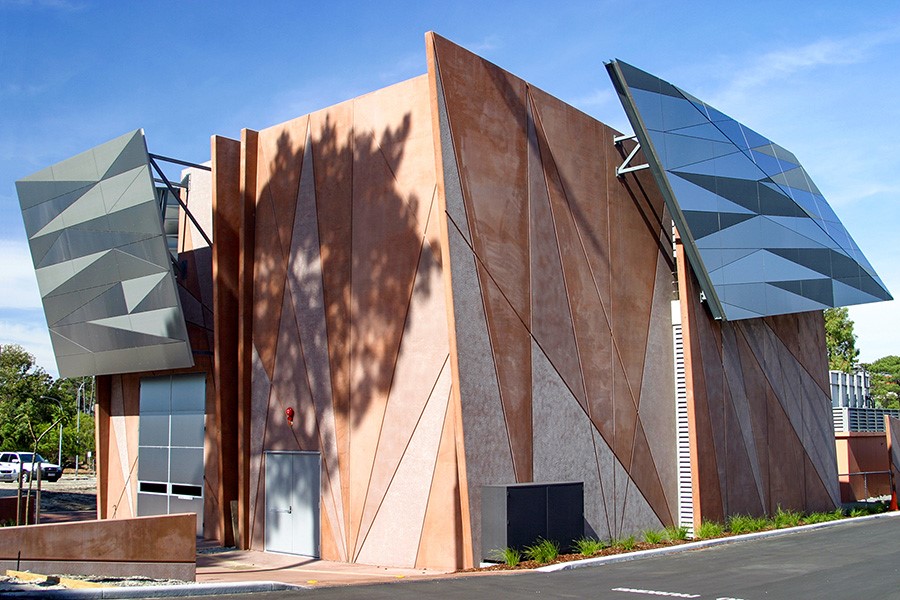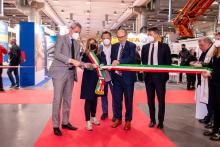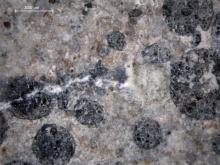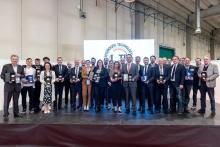
In the run-up to the show GIC has set out concrete sector themes set to spark discussion and innovation throughout the event - from meeting burgeoning demand, to driving sustainability, and managing the entire lifecycle of concrete structures.
1. The growth of green concrete
The concrete industry is acutely aware of its sustainability challenges. Cement production alone is responsible for an estimated 5-10% of global CO2 emissions, while the broader concrete production process consumes substantial quantities of raw materials, energy, and water. At GIC 2024, participants will focus on solutions to mitigate concrete’s environmental impact, including green concrete, which incorporates waste or recycled materials as at least one of its components. By using blast furnace slag, fly ash, or reclaimed aggregates, green concrete reduces the material and energy consumption, as well as the emissions, associated with traditional concrete production and fosters a circular economy, reducing waste sent to landfills. Encouragingly, this more sustainable product is rapidly gaining traction, with the market for green concrete projected to experience a compound annual growth rate (CAGR) of 9.45% from 2021 to 2028 and poised to reach a value of USD $44.65 billion by 2028.
2. The potential for carbon capture in concrete
Another exciting sustainability development in the concrete industry to be discussed at GIC 2024 is the mineralisation of CO2 during concrete production – a process that removes CO2 from the atmosphere and locks it into the material. Concrete naturally absorbs CO2 over the course of decades, but this weakens the structure and accelerates the corrosion of the reinforcing rebar. Using sodium bicarbonate (baking soda) to stimulate early carbonate formation during concrete mixing and pouring, however, could prevent future degradation while capturing up to 15% of the CO2 emissions associated with cement production. The concept of carbon capture in concrete is not entirely novel but the urgency to address climate change has spurred renewed interest in its potential. When combined with other innovations in low-carbon concrete admixtures, it could even lead to the development of carbon-negative building materials.
3. Increasing demand for pre-cast concrete
Modularisation is becoming increasingly common in the construction industry as a way to save time, labour, and costs, while ensuring consistent quality – and precast concrete plays an important role in this trend. The global market for precast concrete is expected to grow at a healthy 6% GAGR between 2022 and 2032, reaching a staggering value of USD $218.79 billion by 2032. At GIC 2024, attendees will witness firsthand the surging popularity of precast concrete, evidenced by the diverse array of materials, equipment, and services showcased. From tilting and fixed tables to block making machines, slab production equipment, curing warehouses, and an assortment of formwork moulds – both dry and wet-cast – GIC 2024 will serve as a comprehensive showcase of the precast concrete sector's robust growth and innovation.
4. 3D printing with concrete
While prefabrication with moulds is enabling the use of more complex and customised concrete elements, so too is 3D printing – another hot topic for the industry at GIC 2024. Though still in its early stages, this technology has the potential to manufacture concrete in intricate shapes and patterns with unprecedented precision and efficiency. The process begins with the development of a digital model or blueprint of the structure to be created, which is then fed into a large-scale 3D printer to meticulously deposit layers of concrete and gradually build up the shape according to the design. Some advanced systems can even integrate reinforcing materials such as steel bars during the printing process. Not only does concrete 3D printing unlock greater architectural freedom, but it also speeds up construction, reduces labour demands, and minimises waste, offering a potentially even more cost-effective and sustainable approach to construction with prefabricated concrete elements.
5. Digitalisation in the concrete industry
The concrete industry is no exception to the march of digitalisation, and 3D printing with concrete is just one example of its manifestation. From quarries to cement batching plants, businesses are using connected machines and following Industry 4.0 principles to streamline production, boost efficiency, and perform preventative maintenance to maximise equipment uptime. Meanwhile, architects, engineers, prefabrication companies, and construction contractors are using virtual design and building information modelling (BIM) to create digital twins of building projects. This software enables them to track progress and manage materials and logistics efficiently to complete projects on time, within budget and with consistent quality and minimal waste. At GIC 2024, there will be plenty of discussions on how to leverage digitalisation to improve products and overall business performance at every level of the concrete industry.
6. The emergence of self-monitoring concrete
Another significant advancement in digitalisation within the concrete industry is the emergence of self-monitoring or self-sensing concrete, which can communicate its structural health in real time. Self-monitoring concrete is created by adding carbon-based fibres to the concrete mix, which alter its electrical properties. This enables readings of electrical resistance to detect various parameters, such as strain, stress, temperature, moisture, and even corrosion levels. It can give an early indication of potential issues like cracks, corrosion, or deformation and prompt repairs before they can escalate into expensive or even dangerous problems. In this way, self-monitoring concrete can help to reduce maintenance costs, improve the reliability and safety of structures, and extend their lifespan.
7. The rise of self-healing concrete
Besides self-monitoring concrete, self-healing or self-repairing concrete is another exciting innovation in smart concrete technology as it can instantly repair cracks that appear over time, reducing maintenance needs and costs and extending the lifespan of concrete structures. There are two main approaches to this: bacterial and micro-capsule methods. The bacterial method incorporates micro-organisms into the concrete mix that react with moisture and oxygen to produce crack-filling limestone. Micro-capsules, on the other hand, contain a healing agent that is released upon cracking, initiating repairs. Although the technology is still in its infancy, the self-healing concrete market shows immense promise as construction priorities shift towards long-term maintenance, longevity, and sustainability, and is forecast to surge at a GAGR of 31.7% between 2022 and 2030, reaching USD $507 billion by 2030.
8. The growing use of concrete flooring
Concrete flooring is witnessing a boom in popularity in commercial and industrial settings for its exceptional durability that withstands heavy foot traffic and machinery loads, low maintenance requirements, and ease of cleaning. The global concrete flooring market is projected to grow at a CAGR of 5.3% from 2022 to 2030, reaching USD $61.4 billion by 2030, driven largely by demand from factories, warehouses and distribution centres, transportation hubs, and healthcare facilities. Reflecting this market strength, GIC will showcase a wide range of products and services dedicated to concrete flooring. Visitors can expect to see solutions including floor grinders for surface preparation, laser screen machines for precise levelling, floor joint materials for seamless transitions, diamond blades for cutting and polishing, and new resins and coatings for enhanced performance and aesthetics.
9. Coloured concrete for decoration
Concrete is also being used in an increasingly decorative capacity, signifying its shift from a practical building material to a conscious design choice. Beyond its lower cost, higher moisture resistance, and lower maintenance than natural stone, such as marble or granite, concrete holds a certain style appeal. Evidencing this trend, the global decorative concrete market is expected to reach USD $20.5 billion in 2025, having grown at a robust 5.9% CAGR since 2020. While stamped concrete for flooring dominates this market, architects and designers are increasingly using coloured concrete to infuse both floors and walls with vibrant hues. Among the GIC exhibitors showcasing concrete pigments, Oxerra, one of the world's leading manufacturers of synthetic iron oxide pigments for the construction industry, will be leading a seminar titled “The Beauty of Colour in Concrete”, offering guidance on how to achieve the best colour quality.
10. End-of-life solutions for concrete structures
Concrete was instrumental in the post-war reconstruction and development of Europe's buildings and infrastructure. However, as these structures near the end of their lifespan, there is a burgeoning interest in equipment and services for their demolition, deconstruction, and recycling. The aim is to pave the way for new construction in a safe, efficient, and sustainable manner. Acknowledging this growing trend, GIC 2024 will not only showcase such innovative products but also honour the significance of concrete demolition and recycling in the inaugural Italian Demolition & Recycling Awards (IDRA).
GIC says that these trends underscore the dynamic evolution underway in the concrete industry as it seeks to redefine its efficiency and sustainability
Register for a free visitor’s pass at www.gic-expo.it










